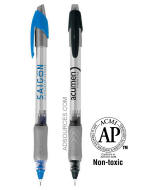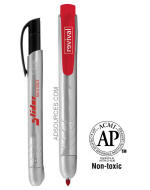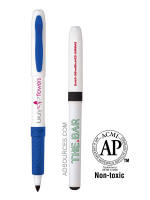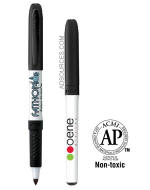|
Bic |
Bic |
Bic |
Bic |
|
|
|
|
|
|
Bic # |
Bic # |
Bic # |
Bic # |
|
|
|
|
|
Bic |
Bic |
Bic |
Bic |
|
|
|
|
|
|
Bic |
Bic |
Bic |
Bic |
|
|
|
|
Gel pen
A gel pen uses ink in which pigment is suspended in
a water-based gel, because the ink is thick and
opaque, it shows up more clearly on dark or slick
surfaces than the typical inks used in ballpoint or
felt tip pens. They can be used for many types of
writing and illustration.
The general design of a gel pen is similar to that
of a regular rollerball pen, with a barrel
containing the writing mechanism and a cap, and a
reservoir filled with ink. The barrels can be
created in many different sizes and designs; some
have finger grips of rubber or plastic. The size of
the nib or pen tip ranges from 0.18 mm to 1.5 mm.
[edit] Inks
The main advantage of gel ink is its high viscosity,
which supports a higher proportion of pigments in
the medium. The pigments are typically copper
phthalocyanine and iron oxides, and the gel is made
up of water and biopolymers, such as xanthan gum and
tragacanth gum, as well as some types of
polyacrylate thickeners. The pigments are opaque,
and gel pens are available in a rainbow of bright
and pastel colours, as well as opalescent, metallic,
and glittery colours which show up clearly on dark
paper.
Gel pens
Ballpoint pens use a paste ink based on a dye solute
in an alcohol solvent. Compared to ballpoint pens,
gel pens:
* Create a bolder line
* Smudge less
* Have occasional skips, due to the ball being less
evenly coated with ink
* Use more ink, leading to more frequent refills or
replacements
* Ink can leak sometime when the stopper fluid drain
out [2]
Fountain pens and liquid-ink rollerball pens use a
dye solute in a water-based solvent. Compared to
these pens, gel pens:
* Are less prone to bleed through to the other side
of a piece of paper
* Create finer, more controlled lines with fewer
blots
* Can create white or brightly coloured opaque lines
on dark surfaces
Paint markers use an oil-based paint/ink that is
very opaque and overlays all other colours beneath
it. Compared to paint markers, gel pens:
* Are much smaller, with finer tips
* Have no odour and do not require shaking to mix
pigment with solvent
India ink (based on carbon black pigment) is perhaps
the ink closest to gel ink in opacity, although it
is usually made with an alcohol and shellac-based
binder.
Another trait of gel ink is that it resists common
laboratory analysis. The United States Secret
Service has maintained the International Ink Library
for many decades. Because manufacturers change their
ink formulas slightly from year to year, thin-layer
chromatography (TLC) can be used on ink from
traditional pens to trace the manufacturer and date
of manufacture of most inks. The pigments in gel ink
do not dissolve, and therefore cannot be analyzed
with TLC.[3]
|
 >
>![]()
![]()
![]()
![]()
![]()
![]()














